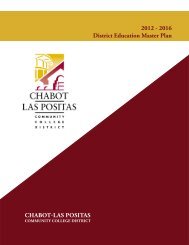City College of San Francisco - California Competes
City College of San Francisco - California Competes
City College of San Francisco - California Competes
Create successful ePaper yourself
Turn your PDF publications into a flip-book with our unique Google optimized e-Paper software.
THEME III<br />
The recommendation process demanded extensive dialog. After each recommendation was completed and<br />
deemed ready by the AHCC, it was then sent to the appropriate Shared Governance committee for more<br />
discussion and recommended action. Many <strong>of</strong> the recommendations had to be discussed and approved<br />
by more than one Shared Governance committee, so this process sometimes required additional dialogs.<br />
The Board <strong>of</strong> Trustees and the community were kept abreast <strong>of</strong> the progress <strong>of</strong> the Enhanced Self-Study<br />
through several information-sharing venues and some dialogs: through the Chancellor’s addresses at FLEX<br />
day each semester and his report to the Board; through actual participation on committees; and through<br />
the Academic Senate President’s report. Regular updates on the ESS were provided to the <strong>College</strong> community<br />
though articles in <strong>City</strong> Currents and through the <strong>College</strong> website. Comments and questions were<br />
encouraged throughout the process. Three critical <strong>College</strong> Shared Governance committees also provided<br />
valuable input during their discussions <strong>of</strong> the ESS recommendations: the <strong>College</strong> Council, composed <strong>of</strong> all<br />
department chairs and head administrators; the Department Chairs Council, composed <strong>of</strong> all department<br />
chairs; and the Chancellor’s Cabinet, composed <strong>of</strong> all head administrators.<br />
At the end <strong>of</strong> the Enhanced Self-Study, a questionnaire was distributed to 170 participants for feedback<br />
about the process. The findings revealed that interest in improving student success was the prime<br />
motivating factor for participation and that most participants felt that the process <strong>of</strong> identifying priorities<br />
was comprehensive and effective, with ample opportunity to share ideas and to hear differing points <strong>of</strong><br />
view. They also indicated that because <strong>of</strong> the experience with the ESS, institutional awareness <strong>of</strong> the issues<br />
affecting student success had been raised.<br />
Outcomes from the ESS are significant and still underway. Thirty-four (34) recommendations came from<br />
the five ad hoc committees, 27 <strong>of</strong> which have been either approved and implemented or approved but<br />
put on hold for various reasons. Three examples <strong>of</strong> improvements resulting from this dialog-intensive<br />
process are:<br />
• extending matriculation support by changing the criteria by which students receive matriculation<br />
services, to ensure that a wider range <strong>of</strong> basic skills students avail themselves <strong>of</strong> these services;<br />
• identifying the need for a <strong>College</strong> assessment plan and implementing an ongoing program<br />
<strong>of</strong> student outcomes research, dissemination, and response; and<br />
• providing early intervention for pre-collegiate basic skills students by identifying pre-collegiate basic<br />
skills students as those whose placement test scores place them in Math E or an English or ESL course<br />
that is non-degree applicable. The purpose <strong>of</strong> the identification is to improve their access to proper<br />
counseling services.<br />
Service Learning and Associated Student Elections—Student-Initiated Dialogs. Students sometimes<br />
initiate dialogs related to their learning and issues <strong>of</strong> importance to them. There are many inspiring examples<br />
<strong>of</strong> how service learning has transformed the learning experience for students, but only two examples<br />
can be described here: an environmental education experience and one <strong>of</strong> Project SHINE’s initiatives. Both<br />
<strong>of</strong> these examples are coordinated through the Office <strong>of</strong> Mentoring and Service Learning, using its advisory<br />
group and ongoing dialogs with faculty, students, and community organizations.<br />
Students in Biology 20 (Introduction to Ecology) approached their instructor in 1998 requesting more<br />
hands-on experience in ecology. After discussion with the students, the instructor put them in contact<br />
with the site stewardship coordinator <strong>of</strong> the Golden Gate National Parks Conservancy (GGNPC) and<br />
agreed to <strong>of</strong>fer extra credit points to all students for a Saturday morning spent restoring critical habitat<br />
in the national parks around <strong>San</strong> <strong>Francisco</strong>. After the instructor and the GGNPC site coordinator agreed<br />
to organize the habitat restoration mornings so that there would be about an hour <strong>of</strong> instruction to three<br />
hours <strong>of</strong> work, students and the instructor met with the GGNPC site coordinator to learn more about the<br />
286 CITY COLLEGE OF SAN FRANCISCO







